What's Your Release Style? Part 2
May 2013
- by Kelvin Miyahira
Distinguishing the Different Release Styles
Last month, I enumerated all the possible movements, so this month let’s get into the business of identifying the various combinations of movements that define the various release styles. This isn’t as complicated as you think since some movements are tied to others and it will simplify this process while also pointing to root causes. Once you know what the root causes are, you can more easily fix or at least negate the larger potential errors of your release style.
Since I’ve covered all the moves of the drive/holders, I will not go over them again in this article. But I will use the drive/hold release as the reference to compare others against. So let’s start by examining what I had termed the “knife edge” release.
Drive/Hold vs. Knife Edge Release
Knife edge strikers are a subset of the drive/holders.The prominent feature distinguishing knife edge strikers from the other DH’ers is their extremely strong grip.
This correspondingly brings about different impact movements which also serve to stabilize the release through impact. Instead of left wrist flexion/slight supination at impact along with right hand flexion/supination, they employ left wrist extension/pronation along with right hand flexion/supination.
Contrast the knife edge release to the drive/hold release.
Everything else about the knife edge release will be the same as the drive/holder’s release.
Flip Release Types
The flip release is generally characterized by the club passing the left forearm before impact due to a high rate of right wrist flexion. However, not all flip releases were created equal.
There are seven different types of flip releases. These are, in descending order of effectiveness: underflip, underflip w/right side rolling, flip ‘n drive, flip/roll hook bias, extreme underflip, slice/fade flip, and the Jekyll/Hyde flip/roll.
Underflip
The underflip is the best release type if you’re going to flip it and is characterized by the club passing the left forearm just one frame before impact. It has stable clubface movements with the only downside being reduced distance due to the added loft and spin. For the many flip/rolling golfers shooting for the stars ie.to drive/hold, mastering the underflip would be akin to landing on the moon. It shares many movements with the drive/hold release but to a lesser degree. The golfer gets through impact looking almost like a drive/holder but falls one frame short.

For whatever reason (one might say that this is a difference in teaching philosophy), the underflippers may not be in the same positions as drive/holders therefore have to make some compensations to make their swings work. I have a theory on this. So follow me on what I think is really going on.
Aesthetics and Swing Beautification
Generally speaking the golf world is currently obsessed with beautiful swings. Beautiful here means appealing to the eye or the fantasy world of 2D video planeology. Thus we have an inclination towards a flattish backswing.
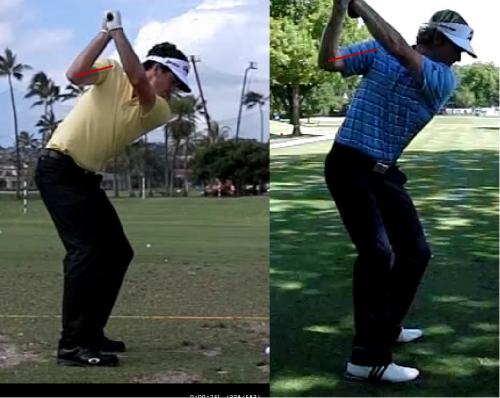
Keegan surely looks a lot uglier.
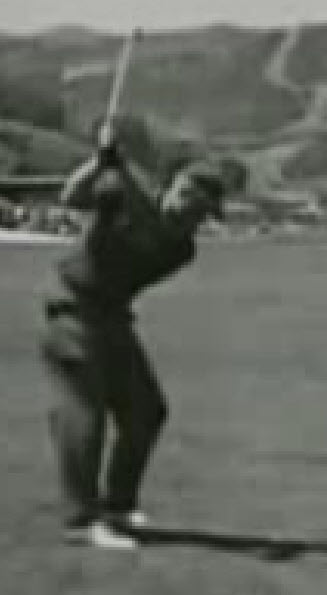
Never mind that the greatest golfer of all time had a steep plane, flying right elbow and heavens forbid a “cross the line” backswing. Nicklaus sure looked ugly.
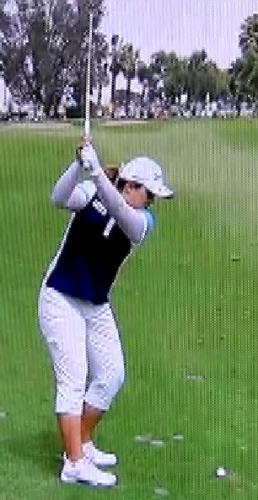
Judy Rankin could not remember anyone with such as steep backswing as current world #1 ranked woman Inbee Park. Hmmmmm.
Ignoring the lessons from the greatest golfer of all time, everyone is taught a flat backswing which causes right shoulder transverse abduction (it is the opposite direction of the elbow move which is transverse adduction). In other words, the right arm moves only slightly up from address position and gets behind the body (humerus lines up with right clavicle). Contrast that with Keegan who keeps his right arm more in front.
How will this affect the downswing?
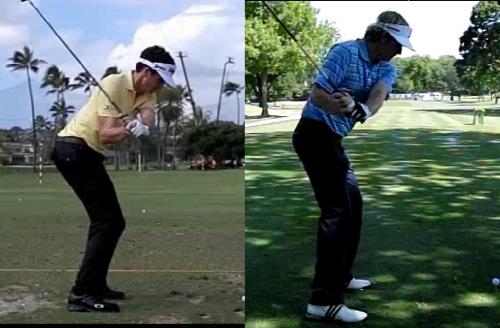
Well, athletic people will use a right elbow move (transverse adduction) and some lateral bend which will flatten the plane. And Keegan makes a massive plane switch from an upright plane to a much flatter one. Why must he perform such a seemingly inefficient move? Shouldn’t he flatten his backswing and simply swing down the same plane he went up on? Since Brandt was not so upright in the backswing, his transition to the perfect plane on the downswing should be much simpler, no?

If you take a closer look at the anatomical movements and positions at this point in the downswing, who is in a better position? Brandt also flattens his downswing but his right elbow is now more stuck behind his hip. His left arm is more behind as well and given these positions he’s got two choices, either gun the engine like Furyk and hit it with the right elbow stuck behind or stall the body and throw the club in front.
So if Brandt picks option 1 and guns the engine, it will cause his right elbow to get even farther behind. And since no one wants to copy the good but idiosyncratic swing of Furyk he must opt for the logical solution... slow down the body and throw the arms in front.
So he starts with the toned-down hip rotation, fires the arms in front (causing early right shoulder internal rotation, early right elbow extension) and doesn’t develop as much lateral bend (releases it earlier too).
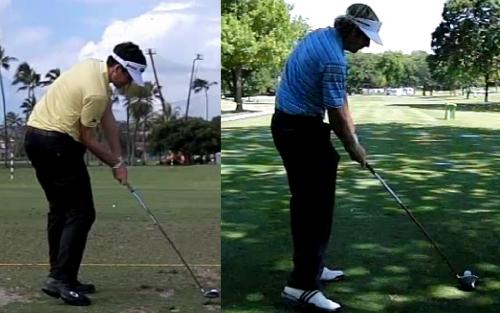
That should explain the difference in impact positions.
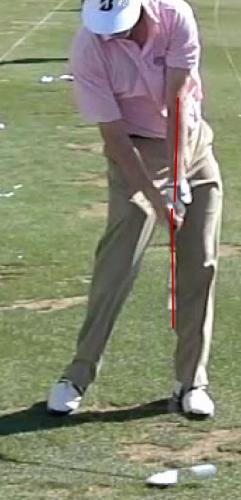
Unfortunately this all leads to left wrist extension hence the slightly early flip or what I’m calling the underflip release.
With all that going on, you can see that even if he wanted to get into a more drive/hold position to hit it longer, it would be pretty difficult. There is a host of problems keeping this racecar from running faster (how do you swing faster when you’re backing off the accelerator?).
One consideration with any flip type other than the flip ‘n drive is that the high rate of right wrist flexion will cause the clubhead to approach at a far shallower angle of attack than a drive holder. Consequently, hitting out of the rough can be challenging. Here’s Karen Stupples practicing out of the rough and catching these shots a little heavy due to the shallow angle of attack.
The table below summarizes how the underflip release differs from the drive/hold. The background color coding will be used to highlight differences and similarities.
Green = same
Yellow = slight difference in magnitude or within an acceptable range
Red = extreme use of otherwise correct movement or reverse movement.Not recommended
| Anatomical Movement | Drive/Hold | Underflip ie. Snedeker |
| left forearm | early supination | some but not enough early supination |
| left wrist | flexion | extension |
| left shoulder | internal rotation | internal rotation |
| left shoulder frontal view | abduction | less abduction |
| left shoulder sagittal | slight flexion (arm lifts) | neutral |
| left elbow | flexion | extension |
| right forearm | supination | supination |
| right wrist | flexion low rate | faster flexion |
| right shoulder | late internal rotation | slight early internal rotation |
| right shoulder frontal view | adduction (arm pulls toward sternum) | less adduction |
| right shoulder sagittal view | slight flexion and steady | increasing flexion |
| right elbow | flexion (bent) | extension |
| both wrists | moving to UD max just after impact | tries to retain RD |
| lateral bend | lateral bend | early release |
| lordosis | lordosis | lordosis |
Underflip with Right Side Rolling Release
This is a variation of the underflip release. Instead of using left forearm supination and right wrist flexion with no right forearm pronation, this release uses right forearm pronation, much less right wrist flexion and no left forearm supination to rotate the clubface. In other words, clubface rotation comes from the right side vs. the left.
Justin Rose, Olin Browne and many LPGA women use a release that works quite well if you just can’t seem to get early left forearm supination. Since there’s nothing worse than a flip and a roll of both forearms, they lock their left arm straight which allows for left wrist extension and left forearm pronation (in other words no closing rotational movements from the left side) and then uses right forearm pronation and radial deviation to create clubface closure.
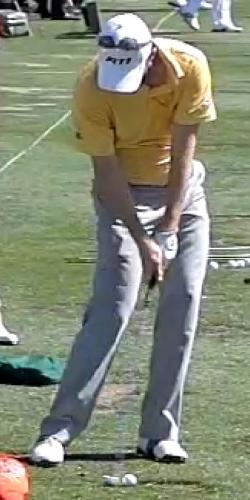
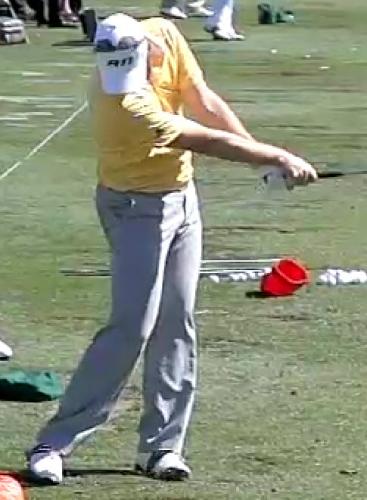
Rose has a low rate of right wrist flexion and body slide (although a little stall) which allows for a good amount of shaft lean but right at impact the left wrist extension increases which adds an underflip element to this release. Thus, while the picture below appears to be a lot of rolling going on, it’s a bit of an illusion.
Justin Rose recent record shows that this release may be very accurate. The comparison with the underflip highlights a very important requirement that applies for all releases – controlling clubface closure rate. There is no great mythical release that does not require clubface rotation (unless you want to slice it). Even knife edge strikers have some left forearm supination until just prior to impact.The question then becomes where the rotation of the clubface comes from and when it happens. Thus, clubface rotation can originate from the left, right or both sides of the body and can occur early or late in the downswing, before or through impact. Pros have figured out different combinations that allow them to be more consistent and stable at impact than amateurs. We delve deeper into this later on in the Clubface Rotation Control chapter.
| Anatomical Movement | Drive/Hold | Right Side Release ie. Rose |
| left forearm | early supination | pronation |
| left wrist | flexion | extension |
| left shoulder | internal rotation | internal rotation |
| left shoulder frontal view | abduction | adduction |
| left shoulder sagittal | slight flexion (arm lifts) | neutral |
| left elbow | flexion | elbow extension |
| right forearm | supination | pronation |
| right wrist | flexion low rate | low rate of flexion |
| right shoulder | late internal rotation | slight early internal rotation |
| right shoulder frontal view | adduction (arm pulls toward sternum) | slight adduction |
| right shoulder sagittal view | slight flexion and steady | flexion |
| right elbow | flexion (bent) | slight flexion |
| both wrists | moving to UD max just after impact | RD |
| lateral bend | lateral bend | early release of LB |
| lordosis | lordosis | loss of lordosis |
Pro Flip or Flip’n Drive Release
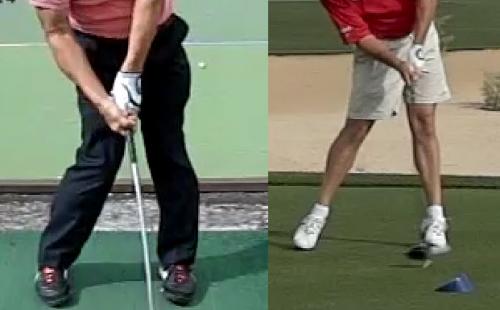
Pro flippers release the lag early via right shoulder internal rotation, right forearm pronation and ulnar deviation. This is almost identical to the amateur slicer on the left with one huge difference. Lee might have begun releasing early but he then drives through impact (frontal left shoulder abduction, shoulder extension and he is even supinating his left forearm/pronating right forearm just before impact to help square the clubface). In contrast, the amateur stops firing the larger muscles, focuses on firing right wrist flexion and right forearm supination causing the shaft to lean away from the target at impact (adding a lot of loft), swinging the path way to the left and keeping the clubface wide open.
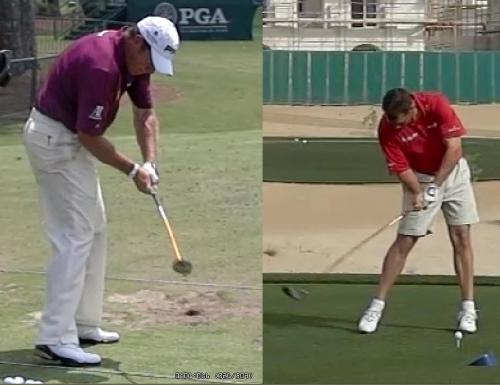
Left shoulder abduction, shoulder extension and internal rotation pull Lee’s left arm back (shall we say chicken wing?) and stabilize impact. Such stability is why this swing could also be called flip ‘n drive and illustrates how the truly athletic can play wonderful golf from poor positions that the average Joe has no idea how to recover from.
One other consideration for the pro flip release is the slightly different plane. It should be a bit steeper from the 9 o’clock shaft position till impact for a crucial reason. The early release of the wrists will cause the low point of your swing to be too far behind the ball if approaching from too flat an angle. Therefore the club MUST be “on plane” or somewhat steeper in order to get bottom of the swing arc to be in front of the ball.
Side note: Drive/holders can swing on any plane and any path. From the steep/path left of Simon Dyson, Brendan De Jonge, Robert Garrigus, Pat Perez and others to the flat/path right of Dustin Johnson and Lee Trevino, the fact that they can retain their lag and keep driving allows them a swing that can hit the ball cleanly (get low point in front the ball) from practically anywhere. All other release styles are very plane dependent or require huge body slide left and must be paired with the matching path or the low point of the swing will be negatively affected (low point gets farther behind the ball creating fat and thin shots).
| Anatomical Movement | Drive/Hold | Flip ie. Westwood |
| left forearm | early supination | slow late supination after left wrist extension |
| left wrist | flexion | early extension |
| left shoulder | internal rotation | internal rotation |
| left shoulder frontal view | abduction | abduction |
| left shoulder sagittal | slight flexion (arm lifts) | extension (arm pulls behind body) |
| left elbow | flexion | massive flexion |
| right forearm | supination | pronation |
| right wrist | flexion low rate | low rate flexion |
| right shoulder | late internal rotation | very early internal rotation |
| right shoulder frontal view | adduction (arm pulls toward sternum) | slight adduction |
| right shoulder sagittal view | slight flexion and steady | slight flexion |
| right elbow | flexion (bent) | flexion |
| both wrists | moving to UD max just after impact | early UD max |
| lateral bend | lateral bend | early release |
| lordosis | lordosis | slight loss of lordosis |
Golf for Women
The pro flip method is easy to perform for some beginners and women. Flip then pull hard with the left arm abduction and shoulder extension. Generally speaking, golfers with low clubhead speeds need some type of flip release in order to get enough spin to keep the ball airborne. But for a big guy like Westwood, it costs him some distance due to increased spin.
Extreme Underflip
This release is never found on the men’s tour. The golfer with this release will lose too much distance with extreme amount of added loft and backspin.

If you were to look at this screen capture from a 60 fps video, you would say it’s a pretty good impact position.
Yet, look at this animation of the three frames near impact for the whole story. It’s probably not what you’d expect but does it make sense that this strong underflip or high ROF will add loft/spin and cause him to lose distance?
I never thought I would see such an extreme case of underflip on any tour. Yet to my surprise, here it is. Hitting fat shots is going to be inevitable from time to time unless one slides farther left and/or jumps up.
Slice/Fade Flip Release
A close cousin to the extreme underflip release, the slice/fade flip release differs by having more slice sidespin. Due to a poorer over the top motion, out to in path or the fact that this release has no left forearm supination/right forearm pronation to close the clubface, the slice/fade flip releasers consistently slice or fade the ball. Though this release can be extreme as in a banana ball slicer’s or mild as in a typical weak fading average Joe golfer, the movement patterns are the same. The slice/fade flip release is also hampered by the flip thus adding a lot of loft and backspin to the already high amount of slice sidespin. Even if it were a consistent fade, in no way would this release produce the power fade that a Bubba Watson or Lee Trevino could hit. The only way to hit a power fade is to drive/hold. Anything less will produce a floating high fade that costs distance.
As you would imagine, this release is not used on tour. It is the way many beginner golfers instinctually would swing the club. Thus, many beginners slice the ball and work to overcome this poor release pattern. We shall see later that this pattern, ingrained as a beginner can come back to haunt a person long after they make it to the tour.
From the anatomical perspective, the closing of the clubface comes from either left forearm supination or right forearm pronation. It can be helped by left shoulder external rotation but in general, if you don’t have those moves, there is no way to roll the clubface closed or anywhere near square.
Combine that with a path moving radically left due to ulnar deviation plus left forearm pronation/right forearm supination (opening moves) and it will produce a banana ball slice or at the very least high, weak shots.
That clubface is extremely open 8” before contact due to left forearm pronation/left wrist extension. Getting it to square is always going to be difficult.
| Anatomical Movement | Drive/Hold | Flip/Roll Slice |
| left forearm | early supination | pronation |
| left wrist | flexion | extension |
| left shoulder | internal rotation | internal rotation |
| left shoulder frontal view | abduction | abduction |
| left shoulder sagittal | slight flexion (arm lifts) | extension |
| left elbow | flexion | extreme flexion |
| right forearm | supination | extreme supination |
| right wrist | flexion low rate | high rate flexion |
| right shoulder | late internal rotation | extremely early internal rotation |
| right shoulder frontal view | adduction (arm pulls toward sternum) | abduction until just before impact |
| right shoulder sagittal view | slight flexion and steady | Neutral |
| right elbow | flexion (bent) | early extension moving to flexion |
| both wrists | moving to UD max just after impact | late UD |
| lateral bend | lateral bend | no lateral bend |
| lordosis | lordosis | loss of lordosis |
Flip/Roll Releases
Given that slicing or weak fading is one of the worst ways of striking the ball, most people will seek a fix. Turn the hands over, let the club pass your hands at impact, make the toe of the club pass the heel at impact, close your stance, re-hinge wrists faster and so on.
If any of the above works for you, congratulations you’ve just turned yourself into a flip/roller! Said another way, all you’ve done is put a huge Band-Aid on a problem with roots so deep that it will rear its ugly head from time to time regardless of how good you are.
Think of Greg Norman hitting a four-iron from the middle of the fairway on the 18th hole of the Masters into the spectators. That mystery shot isn’t so difficult to understand if you can see the left forearm pronation/left wrist extension before impact just like the slice/fader's. A mis-timed (late) roll of his hands is enough to cause the ball to push way right and into the stands.
With all the adrenaline flowing and all the pressure of a major, this release, which requires exquisite fine motor control is a huge challenge to manage. Therefore is it Norman’s fault that he’s had some of the worst collapses in PGA tour history? I think not. Perhaps instruction let him down. No one brought this flaw to his attention.
Seen from the correct context, the flip/roll release is a last millisecond rescue attempt. It is a necessity because without the flip/roll, a weak slice or fade would be the inevitable outcome.
Flip/Roll Hook Bias
Here’s a single digit handicap flip/roller using left shoulder ER, left forearm supination, left wrist extension and left arm staying adducted combined with right forearm pronation and right wrist flexion. In addition, he also uses some radial deviation which helps to create a swing path that is 5-8 degrees to the right as reported by Trackman. This is a volatile mix of closing ingredients that leads to hitting huge hooks. But when he’s timing it right, he can hit large powerful draws/hooks and play some decent golf.
On his left side, this 20 handicap flip/roller has slight left shoulder ER, left forearm supination along with left wrist extension while, on his right, he has massive right forearm pronation, right wrist flexion and, radial deviation instead of ulnar deviation. This is very much the Federer forehand movement combination that, in golf, causes huge hooks.
Radial deviation shifts the club path farther out to the right and increases the possibility of pushing if the clubface stays a tiny bit open. Then once you start push fading, the common fix becomes the need to roll the clubface even faster through impact which potentially leads to … shall we say …hooking?
| Anatomical Movement | Drive/Hold | Flip/Roll Hook |
| left forearm | early supination | late/fast supination |
| left wrist | flexion | extension |
| left shoulder | internal rotation | external rotation |
| left shoulder frontal view | abduction | adduction |
| left shoulder sagittal | slight flexion (arm lifts) | flexion |
| left elbow | flexion | flexion |
| right forearm | supination | pronation |
| right wrist | flexion low rate | high rate flexion |
| right shoulder | late internal rotation | early internal rotation |
| right shoulder frontal view | adduction (arm pulls toward sternum) | abduction |
| right shoulder sagittal view | slight flexion and steady | extreme flexion |
| right elbow | flexion (bent) | early extension moving to flexion |
| both wrists | moving to UD max just after impact | moves to RD |
| lateral bend | lateral bend | early release |
| lordosis | lordosis | loss of lordosis |
Jekyll/Hyde Syndrome
If you are consistently slicing, weak fading, hitting high short shots or can’t get enough distance, you probably have a slice/fade flip release. If you are prone to hooking or hitting large draws (many good players aren’t hard enough on themselves to admit their draw is really a hook) then you probably are a flip/roll with a hook bias. Lastly, if you hit it everywhere, you know where you stand. You have the Jekyll/Hyde Syndrome (JHS). Of course there are differences in the degree of this affliction. Many amateur golfers would love to have a tour pro’s JHS since the distance is great and the dispersion is much smaller. But imagine being a tour pro with this affliction and competing against a tour pro with a drive/hold release and great short game/putting. There is almost no way to control the ball for four days in a row with JHS. At some point, Mr. Hyde will appear. So let me discuss some of the issues involved.
Plight of the JHS Flip/Roller
In the words of Leonard Hofstadter, the amateur JHS flip/roller with high clubhead speed is truly “attached to another object by an inclined plane, wrapped helically around an axis.” In other words he is screwed. See animation below.
Here’s a kid who flips so early he’s lost all lag angle by the time his hands are by his right thigh. As you would have guessed, his typical shot is a weak high fade/slice. Then, when he tries to get rid of the fade or slice, his natural instinct is to...
Where do you think this ball went? See Lamkin grip logo position difference? It was a massive hook.
For some obscure reason Stewart Cink feels so comfortable in his skin that he’s traded in his old drive/hold release for a flip/roll.
Here’s his old release, although at times he was rolling like Mickelson (to be discussed next). Win a major... change release... hmmmm. Where have we heard that before?
Lastly, the JHS flip/roller has distance control problems as you can imagine. If they hit the ball with too much flip and not enough roll, the ball will go short and right. If they hit the ball with a little flip and too much roll, they will hit it long and left. This is far worse than a roller or drive/holder that doesn’t supinate enough to square the clubface and hits a bit of a pushed shot. Since they have no flip element in their release that adds loft and spin, their distance control will be far better.
Rolling Release
A pure rolling release like Phil Mickelson’s driver swing is very rare amongst amateurs. Most amateurs have a flip/roll release in comparison which means there are elements of a flip or high rate of right wrist flexion involved in the release in addition to the roll.
When compared against a drive/hold release, the rolling release isn’t as stable and repeatable. However, compared to a flip/rolling release it remains light years ahead. Thus anyone with less than 90-95 mph clubhead speed will be effective with this release pattern. At higher speeds golfers will suffer from timing issues with the driver. So basically it’s a very good release pattern for everyone but the pros, yet ironically it is only seen with pros and low handicap amateurs.
When looking at a 60 frames per second video the rolling release is virtually indistinguishable from a drive/holder’s release. The tell-tale signs only become apparent at a higher framerate.
As I mentioned in previous articles, Phil Mickelson is definitely a roller when hitting a driver despite drive/holding his irons.
Rollers (Mickelson as a righty) can have a similar looking position to a drive/holder at impact. However, generally speaking the clubface will be a few degrees more open prior to impact due to a more pronated left forearm position.Therefore the supination occurs late and typically continues to rapidly rotate the clubface through impact.
Another key difference between a drive/holder and a roller resides in the latter’s use of right forearm pronation and increased right shoulder internal rotation through the impact zone. In other words, the roller is using both forearms to rotate the clubface closed in the impact zone. This adds up to an even faster closure rate that is very difficult to time. Contrast that to Tiger (in 2008) who uses right wrist flexion and is slightly supinating his right forearm.
Rollers use left shoulder external rotation. This helps them to close the clubface even faster.
Along with left shoulder external rotation comes left shoulder adduction. Rory’s bad swings are of the roller variety and have more of this element which in effect increases the chances of a huge hook.
Here’s Phil with more sagittal plane shoulder flexion in both arms. This is why his arms are raised and farther away from his body. This can cause the path to shift out to the right causing a higher rate of closure.

Another difference resides in the face that Phil’s right arm is more extended than Keegan’s.
On a positive note, rollers tend to have a low rate of right wrist flexion which helps to stabilize impact. Also Phil’s wrists do not radially deviate through impact. This makes his release far more stable than that of a flip/rolling hooker.
Because the amount of flexion tends to be very small, this actually helps prevent a flip from occurring.This is how a pure rolling release is different and better than a flip/roll. As we have seen with the JHS golfers, adding the flip to the roll compounds one problem on top of another and helps multiply the possible errors.
Here’s how the roller differs from the drive/holder.
| Anatomical Movement | Drive/Hold | Roller ie. Mickelson |
| left forearm | early supination | late and fast supination at impact |
| left wrist | flexion | flexion |
| left shoulder | internal rotation | external rotation |
| left shoulder frontal view | abduction | adduction |
| left shoulder sagittal | slight flexion (arm lifts) | more flexion |
| left elbow | flexion | slight flexion |
| right forearm | supination | pronation |
| right wrist | flexion low rate | low rate flexion |
| right shoulder | late internal rotation | early internal rotation |
| right shoulder frontal view | adduction (arm pulls toward sternum) | less adduction |
| right shoulder sagittal view | slight flexion and steady | extreme flexion |
| right elbow | flexion (bent) | extension |
| both wrists | moving to UD max just after impact | moving to UD max just after impact |
| lateral bend | lateral bend | early release |
| lordosis | lordosis | loss of lordosis |
Clubface Rotation Control
When drive/holding, the squaring or rotation of the clubface occurs early in the downswing and allows the golfer to drive through impact with as little left forearm supination as possible while the right wrist flexion/right forearm supination stabilizes the clubface.
Underflippers achieve clubface stabilization with the same movements albeit with a higher rate of right wrist flexion. Justin Rose’s version of the underflip, effectively an underflip with right side rolling release, accomplishes a similar result by rolling the right forearm (pronation) while stabilizing with left shoulder internal rotation, left forearm pronation and left wrist extension. In this way only one side of the body is producing the clubface rotation while the other side provides the stability.
In contrast, rollers are rolling both forearms fast with a low rate of right wrist flexion. On top of this double dose of high rate of clubface closure elements, flip/rollers with the hook bias complete the trinity with a high rate of right wrist flexion/radial deviation. This can double, triple, or even quadruple the closure rate.
Flip/Slicers can be very consistent. Unfortunately, since they can’t get enough clubface rotation to square the clubface therefore they slice all the time. They are using left forearm pronation/right forearm supination and adding a high rate of right wrist flexion into the mix which is another way of saying they’ve got a double dose of opening elements.
Rate of Closure Consistency
Our release style analyses bring up a vitally important point. There are two aspects that we must consider with respect to clubface rate of closure: magnitude and consistency. On the one hand you have rollers with a high rate of closure epitomized by Mickelson with his driver. While it is not the easiest release to time, it is at the very least consistently high. In other words, one can time the roll if the clubface is open by the same amount each time and rolls/closes at the same fast rate each time. While not easy, it is possible when the timing is very good.
On the other hand, what is the plight of the Jekyll/Hyde Syndrome flip/roller? He in fact has two wildly different releases with two extremely different closure rates; one that is extremely high and one that is so low it may even be a negative value (opening through impact). You can liken this to a car with a variable steering wheel that sometimes turns right when you’re trying to turn the steering wheel left and vice versa. It’s an accident waiting to happen.
Bottom Line
The bottom line is that the average amateur is not doing anything remotely similar to tour pros and is unable to control ballflight at much lower swing speeds. Unwittingly, most amateur golfers are playing with some variation of a flip or flip/roll release and have no idea of how to balance the different forces and muscle/joint movements that are closing and opening their clubfaces. This consequently makes hitting the ball consistently straight and far impossible. And if being consistent means having the ability to consistently hit a weak fade or hook the ball, then that’s about all the type of consistency most amateur golfers can produce.
We have been in the dark for way too long. Relying on planeology or mythical/ambiguous follow through positions to hit the ball straight without understanding what type of release and the micro movements involved is putting faith in pure voodoo. Perfect backswings do not automatically trigger perfect releases. Nor does a perfect follow through, the perfect swing plane, or perfect balance and rhythm actually ensure a good release. If you cannot hit the ball straight and far there is a logical reason. Perhaps it’s time for golf instruction to step it up and start truly helping people instead of creating chronic disease ridden swings that restrict true improvement in this sport.
Next month I’ll start looking at the deep root causes of errors and clusters of movements that will help you fix your release.

